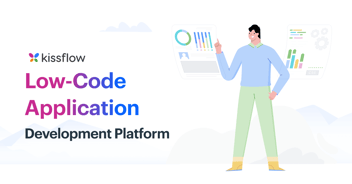
- >
- Application Development >
- How to Accelerate Digital Transformation With AI-Driven Low-Code Apps
How to Accelerate Digital Transformation With AI-Driven Low-Code Apps
According to a report by Microsoft, over 87 percent of IT professionals and CIOs believe that increased automation and AI capabilities, when embedded into low-code platforms, such as AI Low-code Platform, can help them make better use of these platforms. It is a trend we will see more commonly across many low-code tools.
Companies are now investing readily in AI-driven digital transformation to improve operational efficiency, enhance customer engagement, drive continuous innovation, and keep up with the changing market dynamics. Harnessing the power of AI-driven low-code applications can help businesses scale application production, streamline operations, and accelerate digital transformation.
Leveraging AI in low-code platforms for agile application development
Low-code and no-code allow non-technical users or no-coders to reimagine and digitize their business processes without obtaining steep IT experience or spending exorbitantly on IT infrastructure and build apps using AI powered application development platform.
Combining AI with low-code platforms can help organizations solve potential business problems faster and more efficiently. As the benefits of a visual drag-and-drop editor are combined with AI models, end users can choose between using visual elements or natural language processing for app development. In addition to these AI-powered functionalities, tools like free AI image generator assist in creating custom images from simple text inputs, further simplifying the process.
Low-code platforms can also offer chatbots to assist developers throughout the development process. Similarly, AI can produce multimedia assets or text for applications to accelerate the development process further.
How AI enhances low-code applications
AI can accelerate the entire application development process, reduce errors with automation, decrease development time, and improve overall quality. Most importantly, it can further reduce the learning curve for low-code platforms.
Here are some ways AI can improve low-code application development process:
Follow best practices
By integrating developer guidance into the development platform, AI can help developers build applications that follow all the best practices established by the company. These best practices can be provided as recommendations right inside the development environment.
Automate repetitive tasks
AI makes it possible to automate repetitive parts of the development process, like adding data entry fields and creating an overall workflow template based on the business process.
AI-suggested fields
AI can suggest new data fields depending on the type of application you are building, and these fields can be added to forms automatically.
Improved speed and accuracy
It can be challenging and time-consuming to digitize complex manual business processes. When integrated with low-code platforms, AI can streamline this process and enhance accuracy and speed for transforming even the most complex business processes into workflows.
Autocode completion
AI can generate or complete code automatically based on the set of requirements provided by the end user. This can be especially helpful for repetitive coding tasks like setting up database schemas or creating user interfaces.
Automated testing
Testing is an important yet time-consuming part of the app development process. By identifying and generating test use cases based on your specific application requirements, AI can help automate the testing process and save time.
Natural language processing
Natural language processing (NLP) for low-code and no-code application development tools makes it possible for users to create applications by giving direct text-based commands.
Users don’t have to write any code; they can just give direct text commands to add different components to the applications. However, it's important to remember that NLP is still in its nascent stages and isn’t as accurate or error-prone as needed.
Optimization
AI can optimize low-code applications to improve their overall efficiency. It can analyze application framework, workflow, and usage patterns to optimize the application further, improve performance, and increase scalability as well.

Choosing Your App-Development Stack: An 11-Point Checklist
[Free eBook]
Thanks for Downloading!
The impact of AI-driven low-code apps on business processes and customer experience
Low-code platforms can accelerate the application development process with high-customizable, ready-made, and reusable components that can be dragged and dropped to build applications. This democratizes the development process and allows even business users to build applications.
For non-technical users, integration of AI with low-code platforms can lower the learning curve even more. It can allow non-technical users to become citizen developers and create custom applications that align with their specific needs and requirements. When your IT team is already burdened with complex projects, empowering non-technical employees to build their own applications can reduce application development time, save costs, and improve overall efficiency.
More importantly, when people who use these business processes daily are given the tools to transform the process into streamlined applications, it directly leads to custom applications that perfectly align with user requirements, reduce bottlenecks, improve productivity, and provide a better end-user experience.
With AI embedded in low-code development platforms, the focus is no longer on coding. Instead, the focus is on how each pain point of a business process can be effectively resolved through custom applications. With low-code applications, employees have more time to focus on the logic behind the applications and how the overall efficiency and productivity can be improved.
Pushing updates and creating new iterations of the applications to fit the changing user requirements also becomes easier–all of which empower employees to provide a better customer experience.
Example of an AI-driven low-code application (Use case)
Let's assume you are building an application for generating and managing purchase order requests in your organization. The application is built to monitor the progress of every purchase order in real-time and streamline the entire purchase order management process.
While a low-code development platform can be used to design workflow for the purchase order processes using a drag-and-drop editor, AI can be used to manage the simpler functions of the application, like generating images, texts, and chatbot responses for specific prompts. AI can also suggest data fields that should be added to the request forms for the workflow.
At the same time, AI can also provide suggestions based on industry standards and best practices to further optimize the application.
Integrating AI with Kissflow Low-Code
Kissflow is a low-code development platform that is already working to integrate AI, automation, and developer guidance features. By leveraging generative AI and OpenAI, Kissflow has introduced the AI-suggested fields feature that can automatically suggest new data fields to users based on the type of workflow users are trying to build.
For every application the user is building, they can directly drag and drop the AI-generated fields, which can also be pre-populated. Apart from the initial list of suggested fields, users can also refresh the list to get more AI-suggested fields related to the workflow.
The role of AI-driven digital transformation
AI is now a key component of digital transformation. With AI, organizations can effectively unlock patterns and latent insights in their data, which can help them deliver more value to their customers. AI-powered analytics allows organizations to predict customer needs more accurately and generate insights to build powerful business strategies.
Incorporating AI in the different verticals of the organization can improve efficiency, decrease costs, and boost customer experiences. AI can also help automate repetitive tasks, saving time and effort.
Implementing smarter and more compatible business applications powered by AI and low-code platforms allows teams to focus on more important and complex parts of their core responsibilities instead of getting bogged down by boring, manual tasks.
AI and low-code are the future
The rise of AI-driven low-code apps is not the newest trend that will soon fade away–It is the future. By integrating AI into low-code app development and internal business operations, organizations can be better equipped to improve their operational efficiency, meet the constantly changing customer needs, and stay competitive.
But it's just as important to remember that integrating AI in low-code platforms is not a one-time thing. It is an ongoing process that requires constant refining, testing, and monitoring to ensure you can drive innovation and growth.
Where you are in your digital transformation journey?
.webp)
A Common Sense Guide to Digital Transformation [Free eBook]
Thanks for downloading!
Related Articles











